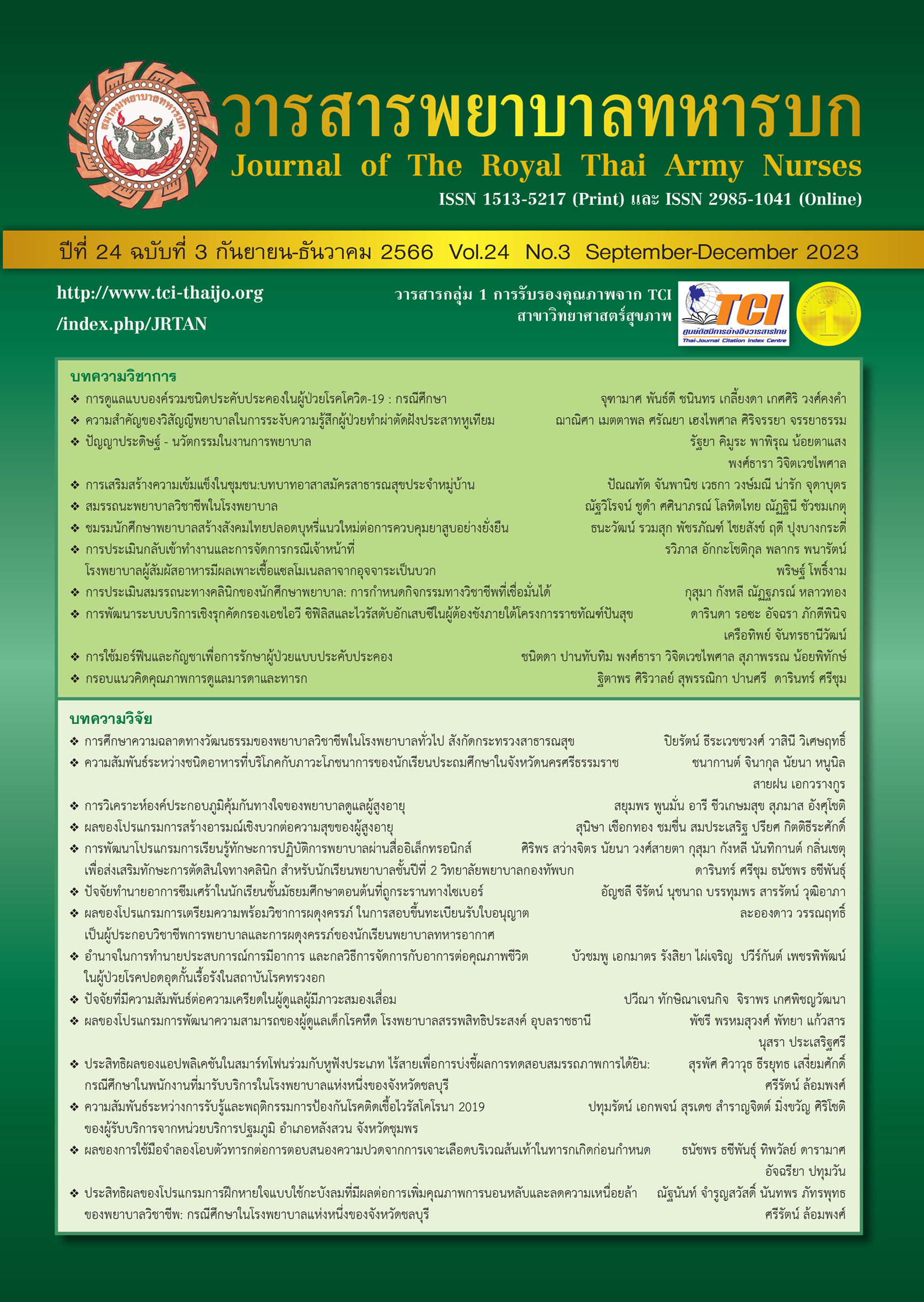Effects of Simulation-Based Learning on Clinical Decision Making Abilities, Secure Communicate Using ISBAR, and Nursing Practice for Patient Safety of Nursing Students
Keywords:
simulation based learning, clinical decision making, ISBAR, nursing practice for patient safetyAbstract
This study was quasi-experimental with one group pretest-posttest design. The purpose of this research aimed to investigate the effects of simulation-based learning on clinical decision making abilities, secure communicate using ISBAR, and nursing practice for patient safety of nursing students. The study sample consisted of 114 students. They taught by the simulation-based learning including 2 situations and each situation consumed 60 minutes. The instruments used in this study were composed of clinical decision making abilities, secure communicate using ISBAR, and nursing practice for patient safety questionnaires. The content validity was 0.90, 0.80, 0.83 and reliability was 0.96, 0.92 and 0.92, respectively. Those were analyzed using descriptive statistics and t-test. The results revealed that nursing students who were taught using the simulation based learning had the mean clinical decision-making ability, secure communicate using ISBAR, and nursing practice for patient safety after the experiment was higher than before the experiment with a statistical significance (p < .05). It is suitable for the current situation in developing nursing practice skills for students so that they can practice nursing with quality and safety for clients.
Downloads
References
Sinthuchai S, Ubolwan K, Boonsin S. Effects of high-fidelity simulation based learning on knowledge, satisfaction, and self-confidence among the fourth year nursing students in comprehensive nursing care practicum. Ramathibodi Nursing Journal 2017; 23(1): 113-27. (in Thai)
Cook DA. How much evidence does it take? A cumulative mete-analysis of outcomes of simulation-based education. Medical Education 2014; 48(8): 750-60.
Jeffries PR. Simulation in nursing education: from conceptualization to evaluation. 2nd Ed. New York: National League for Nursing; 2012.
Koukourikos K, Tsaloglidou A, Kourkouta L, Papathanasiou LV, LLiadis C, Fratzana A, et al. Simulation in clinical nursing education. Acta Informatica Medica 2021; 29(1): 15-20.
Phormpayak D, Sattayawong W, Rattana-Umpa J, Hamtanon P, Rungkavat V. The effects of using simulation based learning and reflective thinking skill promoting on nursing students’ reflective thinking behavior and clinical decision-making abilities. Journal of Baromarajonani College of Nursing, Nakhonratchasima 2019; 25(2): 57-71. (in Thai)
Chubkhuntod P, Elter PT, Gaewgoontol N, Potchana R. Effects of simulation based learning model on knowledge, self-efficacy and abilities of applying nursing process skills during Intrapartum care of nursing students. Journal of Health Science 2020; 29(6): 1062-72. (in Thai)
Sinthuchai S, Ubolwan K, Bunsonti N, Yod-A-sa P, Doungsuriya P. Effect of high fidelity simulation based learning on clinical decision making ability of nursing students. Journal of The Police Nurses 2019; 11(1): 172-83. (in Thai)
Boromarajonani College of Nursing Saraburi. (2022). Report of six domains of learning evaluate of graduated student in academic year. Boromarajonani College of Nursing Saraburi. (in Thai)
Sinsawad P. Learning Management to Develop Cognitive Skills of Nursing Students. Journal of Research and Curriculum Development 2021; 11(2): 35-47. (in Thai)
Braaf S, Manias E, Finch S, Riley R. Communication failure across the perioperative pathway. International Journal of Person-Centered Medicine 2012; 2(4): 698-706.
Tanner CA. Thinking Like a Nurse: A research-based model of clinical judgment in nursing. Journal of Nursing Education 2006; 45(6): 204-11.
Lasater K. Clinical judgment development: using simulation to create an assessment rubric. Journal of Nursing Education 2007; 46(11): 496-503.
Everson J, Gao A, Roder C, Kinnear J. Impact of simulation training on undergraduate cliinical decision-making in emergencies: A non-blinded, single-centre, randomised pilot study. Cureus Journal of Medical Science 2020; 12(4): 1-13.
Boaro N, Fancott C, Baker R, Velji K, Andreoli A. Using SBAR to improve communication in interprofessional rehabilitation teams. Journal of Interprofessional Care 2010; 24(1): 111-4.
Duangchan C. Nursing handoff communication through the SBAR technique. Journal of Nursing, Siam University 2020; 21(41): 91-103. (in Thai)
Phetprasit N, Laimek S, Thiangchanya P. The effects of a simulation-based learning program on knowledge and communication skills for patient safety among perioperative nurses. Nursing Journal CMU 2022; 49(4): 220-32. (in Thai)
Foronda CL, Fernandez-Burgos M, Nadeau C, Kelley CN, Henry MN. Virtual simulation in nursing education: a systematic review spanning 1996 to 2018 2020; 15(1): 46-54.
Kolb AY, Kolb DA. Experiential learning theory as a guide for experiential educators in higher education. A Journal for Engaged Educators 2017; 1(1): 7-44.
Srisa-ard B. Basic research. 10th ed. Bangkok: Suweerivasarn; 2017.
Sinthuchai S, Ubolwan K. Fidelity simulation based learning: Implementation to learning and teaching management. Journal of The Royal Thai Army Nurses 2017; 18(1): 29-38. (in Thai)
Wang W, Liang Z, Blazeck A, Greene B. Improving chinese nursing students’ communication skills by utilizing video-stimulated recall and role-play case scenarios to introduce them to the SBAR technique. Nurse Education Today 2015; 35: 881-7.
Stewart KR, Hand KA. SBAR, communication, and patient safety: an integrated literature review. Medsurg Nursing Journal 2017; 26(5): 297-304.
Fent G, Blythe J, Farooq O, Purva M. In situ simulation as a tool for patient safety: a systematic review identifying how it is used and its effectiveness. BMJ Simulation & Technology Enhanced Learning 2015; 1(3): 103-10.
Berndt J. Patient safety and simulation in prelicensure nursing education: an integrative review. Teaching and Learning in Nursing 2014; 9(1): 16-22.
Downloads
Published
How to Cite
Issue
Section
License
Copyright (c) 2023 Journal of The Royal Thai Army Nurses

This work is licensed under a Creative Commons Attribution-NonCommercial-NoDerivatives 4.0 International License.
บทความหรือข้อคิดเห็นใดใดที่ปรากฏในวารสารพยาบาลทหารบกเป็นวรรณกรรมของผู้เขียน ซึ่งบรรณาธิการหรือสมาคมพยาบาลทหารบก ไม่จำเป็นต้องเห็นด้วย
บทความที่ได้รับการตีพิมพ์เป็นลิขสิทธิ์ของวารสารพยาบาลทหารบก
The ideas and opinions expressed in the Journal of The Royal Thai Army Nurses are those of the authors and not necessarily those
of the editor or Royal Thai Army Nurses Association.






